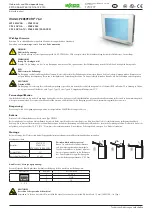
TROUBLESHOOTING AND REPAIR INSTRUCTIONS FOR L&L KILNS
troubleshoot-general.pdf
REV: 4/15/2017
Page 19
2017
L&L Kiln Mfg, Inc. 505 Sharptown Rd, Swedesboro NJ 08085 856.294.0077 F:856.294.0070 [email protected] hotkilns.com
average of about 2195°F for about 25 minutes, instead of
continuing on to 2232°F (cone 6) to finish the firing.
The relationship between time and temperature allows you
to estimate how much hold time to add to get the same
amount of heat work as the kiln would have achieved by
climbing to 2232°F. Assuming a 108°F per hour temperature
rise, a good rule of thumb is to add about a 20 minute hold
to the maximum temperature; this will allow you to lower the
final temperature by about 20°F. An hour hold time would
mean a final temperature of about 40°F lower. A two hour
hold time would be about 60°F lower.
In this example, the kiln has already held at about 35
degrees lower than the final temperature for 25 minutes. It
would need another 25 minutes of holding to give the ware
the same amount of heat work that 2232°F (cone 6) would
have.
In reality, however, an
Err1
that close to the end of
a firing probably means you need new elements. So
re-starting the kiln will probably not enable it to climb much
higher in temperature. Keeping track of the time, let it run,
and when it shows
Err1
again just keep re-starting it until
the firing finishes. Meanwhile call and order new elements.
Be very careful if you try this method. On loads that are
very important always use cones you can see through the
peepholes in case of a failure of some kind. If you have to
use this method without the cones, remember that almost
all your calculations are based on estimates and the results
could be disastrous to your ware and/or the kiln if you are
not accurate enough. The further away the temperature
that the kiln is holding at is from the cone that the firing was
trying to get to, the less accurate an estimated amount of
time will be to achieve the amount of heat work necessary. If
you can wait and re-fire from room temperature, you should.
If you depend in any way on your kiln you should keep
spare parts around for it. You could replace the elements
easily yourself after the kiln cools and then re-load it and
re-fire it to the proper cone without losing much time at
all. Or consider that most glazes have an entire cone’s
temperature range that they can mature within. Weigh your
options and decide.
In general though, Error Codes mostly appear after the
kiln has been disassembled and set back up improperly,
has had its power supply altered (like moving to a new
studio with different voltage), or has had an element or a
thermocouple burn out.
SERVICE FOR YOUR KILN
WHERE TO GET SERVICE
See the SERVICE Section of your Instruction manual or see
hotkilns.com/technical-support
WHERE TO BUY PARTS
You can order parts for your L&L Kiln through L&L or
your local distributor. See the Parts List that pertains to
your particular kiln model. Our on-line parts list is easy
to navigate. See
hotkilns.com/parts
. Standard Parts are
typically shipped the day after an order is placed. Rush
service is available.
REPLACEMENT ELEMENTS
Replacement Elements made by L&L Kiln Mfg., Inc. are
designed for each individual model for long life and superior
performance. Good element design is a complex balance
of watt density, design voltage, stretch ratio, wire gauge,
element length and material. It takes many hours and years
of experience to design a good element for each model. Do
not expect an outside supplier with no interest in your kiln
performance or long experience with L&L kilns to spend the
necessary time to do this right. In the end you will not save
money. See
hotkilns.com/elements
to order elements.
NOTE: Many of these procedures have accompanying
instructional videos. Look out for the video links in each
section or go to hotkilns.com/videos for more.
REMOVING PANEL FOR SERVICE
1) It is easy to access the inside of the control panel for
troubleshooting. In addition it is easy to remove this panel
and send it back to the factory for inspection and/or repair.
2) Disconnect power and unplug the kiln.
3) Follow the instructions in ASSEMBLY INSTRUCTIONS
FOR in the ASSEMBLY tab of your instruction manual
or see
hotkilns.com/assemble-easy-school
in order to
remove the Control Box for Easy-Fire and School-Master
kilns.
4) Pack the control panel with cushioning material such as
bubble wrap, balled-up newspaper or foam in a cardboard
box and follow instructions from the factory or your local
distributor about where to send it. DO NOT SEND A
CONTROL PANEL WITHOUT CALLING FIRST.
















































